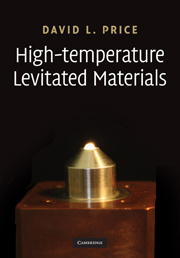8 - Molten oxides
Published online by Cambridge University Press: 23 April 2010
Summary
High-temperature melts with low electrical conductivity have largely been the province of CNL since the other main levitation techniques, EML and ESL, are inconvenient if not impossible for measurements on insulating systems. In fact, from its inception, non-conducting liquids, and in particular refractory molten oxides, have presented the heaviest application of CNL.
Pure trivalent oxides
The molten trivalent oxides Al2O3 and Y2O3, together with their mixtures, by themselves account for the vast majority of measurements with CNL. This is due in part to the scientific as well as technical importance of yttrium aluminium garnet (YAG), Y3Al5O12, an important laser material, discussed in the next section. In addition, pure Al2O3 is of technological interest as the reaction product in rocket engines fuelled by aluminium metal (Parry & Brewster,1991). As a result, molten Al2O3 has often been the material of choice when the opportunity arose for exploiting a new experimental technique with CNL.
The conductivity of molten Al2O3, measured with a contactless technique by Enderby et al. (1997) and Saboungi et al. (2002), is about 6 Ω−1cm−1 at the melting point, indicating the presence of ionic but not electronic conduction. Later measurements (Saboungi et al., unpublished work, 2003) probed the effect of changing the gaseous environment in the levitation system and found a substantial drop in conductivity in a reducing environment (Fig. 8.1). The earlier results of Shpil'rain et al. (1976) on contained samples of molten Al2O3 under argon and in vacuo are in reasonably good agreement with the upper curve in Fig. 8.1.
- Type
- Chapter
- Information
- High-Temperature Levitated Materials , pp. 162 - 203Publisher: Cambridge University PressPrint publication year: 2010

